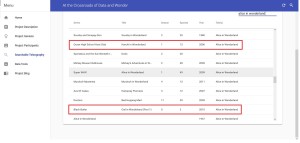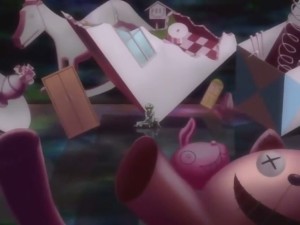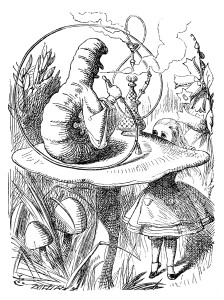This guest post is by Monica Allen of the Winter 2017 394r class.
We all love fairy tales, whether they be old or new, and one fairy tale that is fairly easy to find within TV is Alice in Wonderland, which is especially prominent in Japanese anime. It appears in single episodes and “omakes” (extra non-canon episodes) to complete series. Just a few examples can be seen in the screenshot of the FTTV Database.

One series is Pandora Hearts. Pandora Hearts is a weird little anime (with a much more confusing and long manga) about two kids named Alice and Oz (can you tell who the Alice-character is?). They are trying to stop an evil family from destroying the world while searching for Alice’s lost memories. Both Alice and Oz are Alice-characters and both are trying to figure out just who they are using ways that Carroll’s Alice either thinks about or says. They either face their identity issues head-on or avoid them; through their discovery viewers can see a more healthy way of figuring out identity and a less healthy way.
This theme of identity is prevalent throughout Alice’s Adventures in Wonderland. Near the beginning of the book Carroll’s Alice asks herself, “Let me think: was I the same when I got up this morning? I almost think I can remember feeling a little different. But if I’m not the same, the next question is, ‘Who in the world am I?’” (11). Answering this question does not start in earnest in Pandora Hearts until Oz first falls into Wonderland—here called the Abyss.

Here, even though Oz has just met Alice earlier that day, Alice has no memory of their earlier encounter and is styling herself as the Bloody-Black Rabbit (B-Rabbit for short). This isn’t the only memory problem Alice has. Once the two of them escape the Abyss, all Alice wants to do is find her lost memories. This is quite reminiscent of a conversation between Carroll’s Alice and the Cheshire Cat when Lewis’s Alice says, “I can’t remember things as I used” (30). Likewise, Alice from Pandora Hearts spends the rest of the time trying to find her memories. She wants to know just who she is and makes sure to put herself into situations where her memories might be hiding (since memories are sort of tangible here). Even when some situations are scary or far away if she can learn about herself through these she jumps right in. By this Alice illustrates that who we truly are can be found in these less comfortable situations.

On the other hand, Oz’s identity problems stem from why he was thrown into the Abyss and from his “daddy issues.” In the first episode, Oz’s sister asks what the Abyss is to which she is told that [1]“it’s a prison where they lock up bad people,” specifically bad people “who have committed deadly sins” (18, 1×1). Oz dismisses it as an urban legend used to scare little kids. But later that day in Oz’s coming of age ceremony the keepers of the Abyss, the Baskervilles, come and banish him to the Abyss. His sin? His very existence. Sufficient to say this makes Oz very confused about himself and his relation to everything else.
These two characters go about trying to solve their respective identity problems through two different methods, both of which can be found in the book. Alice’s (anime) first memory is found in a pocket watch that Oz is carrying around with him. This imagery is similar (in more ways than told in the anime) to the White Rabbit of the book. Throughout Alice, Alice is chasing after the White Rabbit; likewise, throughout Pandora Hearts, Alice is chasing after her memories. Both Alices chase the White Rabbit/memories as if “there was not a moment to be lost” (Carroll 6). Alice (anime) runs from memory to memory learning more about herself as she goes. She only hesitates when SPOILER she learns that she died 100 years ago (so why is she alive?), but this is also the end of her pre-Abyss memories.

Conversely, Oz does not run headlong into discovering his identity and the whys of his existence as sin. He more or less ignores the identity issue. At one point in the second episode, Oz has almost been eaten by a chain but instead of freaking out like Alice expects him to, Oz begins to eat cookies. When Alice asks him what in the world is wrong with him, he simply replies, “I’ve already seen enough things that couldn’t possibly be real, so I kinda got used to it. I think it’s easier to accept that this is the way things are” (108, 1×2). So rather than stop or look for an answer he simply accepts his “sin” and goes on with life. In Alice, Alice does something similar when presented with Wonderland. In fact, “so many out-of-the-way things had happened lately, that Alice had begun to think that very few things indeed were really impossible” (7). She too ignores her problems (which are mostly just being in Wonderland) and just continues on her way.
Later, in episode nine, we learn that Oz’s cavalier attitude towards his identity and his surroundings stem from what I graciously term “daddy issues” (parental issues are also discussed in the Ouran High School Host Club Wonderland episode). In flashbacks, we learn that Oz’s dad hates him and wishes that he had never been born. In order to cope with this rejection Oz decided to unhealthily accept it. This rejection is part of the reason why he does not try to figure out his existence, most likely because he is afraid of the answers he will get. Unlike Alice, Oz does let his fears stop him from progressing.

At the end of the series, we get closure for both Alice and Oz. After learning about her death, Alice no longer actively looks for her memories. She doesn’t need to though, since she does know what happened to her. She is able to answer all the questions she had about herself. Oz too resolves his identity issues when he turns to face them rather than “accepting” them ending with him confronting his father. As these two characters figure out who they are, viewers see two different methods of coming to terms with their identities. Oz’s is not very healthy, but he eventually realizes that he cannot just avoid it by “accepting” it. Whereas, though Alice may be a bit too quick at times, Alice sets out to find who she is head on and acknowledging both the good and the bad.